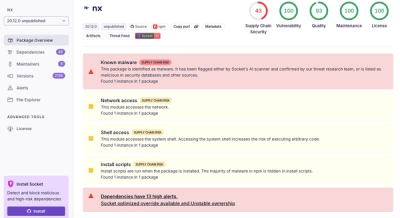
Security News
/Research
Wallet-Draining npm Package Impersonates Nodemailer to Hijack Crypto Transactions
Malicious npm package impersonates Nodemailer and drains wallets by hijacking crypto transactions across multiple blockchains.
Print directory or structured data in a tree like format.
TTY::Tree provides independent directory or hash data rendering component for TTY toolkit.
Add this line to your application's Gemfile:
gem 'tty-tree'
And then execute:
$ bundle
Or install it yourself as:
$ gem install tty-tree
TTY::Tree accepts as input a directory path:
tree = TTY::Tree.new(Dir.pwd)
tree = TTY::Tree.new('dir-name')
or can be given as its input a hash data structure with keys representing directories and values as arrays representing directory contents:
data = {
dir1: [
'config.dat',
{ dir2: [
{ dir3: [ 'file3-1.txt' ] },
'file2-1.txt'
]
},
'file1-1.txt',
'file1-2.txt'
]
}
tree = TTY::Tree.new(data)
You can also construct tree with a DSL:
tree = TTY::Tree.new do
node 'dir1' do
node 'config.dat'
node 'dir2' do
node 'dir3' do
leaf 'file3-1.txt'
end
leaf 'file2-1.txt'
end
node 'file1-1.txt'
leaf 'file1-2.txt'
end
end
The TTY::Tree can print the content in various formats. By default, a directory format is used by invoking render:
puts tree.render
# =>
# dir1
# ├── config.dat
# ├── dir2
# │ ├── dir3
# │ │ └── file3-1.txt
# │ └── file2-1.txt
# ├── file1-1.txt
# └── file1-2.txt
The render call returns a string and leaves it up to api consumer how to handle the tree like output.
In order to create TTY::Tree you need to provide either a path to directory which can be a String, Pathname or Dir:
tree = TTY::Tree.new(Dir.pwd)
tree = TTY::Tree.new('dir-name')
tree = TTY::Tree.new(Pathname.pwd)
Or hash data structure:
data = {
dir1: [
'config.dat',
...
]
}
tree = TTY::Tree.new(data)
As as shortcut notation you can call [] like so:
tree = TTY::Tree[Dir.pwd]
You can also use DSL to build tree by using node & leaf:
tree = TTY::Tree.new do
node 'dir1' do
node 'config.dat'
node 'dir2' do
node 'dir3' do
leaf 'file3-1.txt'
end
leaf 'file2-1.txt'
end
node 'file1-1.txt'
leaf 'file1-2.txt'
end
end
The maximum level of depth for this tree when parsing directory. The initial directory is treated as index 0.
tree = TTY::Tree.new('dir-name', level: 2)
# => parse directories as deep as 2 levels
:file_limitPrevent TTY::Tree descending directories more than # entries:
tree = TTY::Tree.new('dir-name', file_limit: 2)
:show_hiddenIn order to for TTY::Tree to include hidden files in its output use :show_hidden option like so:
tree = TTY::Tree.new('dir-name', show_hidden: true)
To only display directory entries in the output use :only_dirs option:
tree = TTY::Tree.new('dir-name', only_dirs: true)
Listing directories does not inlucde hidden ones. If you wish to show hidden directories as well do:
tree = TTY::Tree.new('dir-name', only_dirs: true, show_hidden: true)
By deafult content is printed using TTY::PathRenderer.
If you prefer a numeric notation of nested content you can use TTY::NumberRenderer to enumerates each nested node like so:
puts tree.render(as: :number)
# =>
# dir1
# 1.1 config.dat
# 1.2 dir2
# 2.3 dir3
# 3.4 file3-1.txt
# 2.5 file2-1.txt
# 1.6 file1-1.txt
# 1.7 file1-2.txt
:indentThe number of spaces to use when indenting nested directories. By default 4 spaces are used.
tree.render(as: :dir, indent: 2)
After checking out the repo, run bin/setup to install dependencies. Then, run rake spec to run the tests. You can also run bin/console for an interactive prompt that will allow you to experiment.
To install this gem onto your local machine, run bundle exec rake install. To release a new version, update the version number in version.rb, and then run bundle exec rake release, which will create a git tag for the version, push git commits and tags, and push the .gem file to rubygems.org.
Bug reports and pull requests are welcome on GitHub at https://github.com/piotrmurach/tty-tree. This project is intended to be a safe, welcoming space for collaboration, and contributors are expected to adhere to the Contributor Covenant code of conduct.
Copyright (c) 2017 Piotr Murach. See LICENSE for further details.
FAQs
Unknown package
We found that tty-tree demonstrated a not healthy version release cadence and project activity because the last version was released a year ago. It has 1 open source maintainer collaborating on the project.
Did you know?

Socket for GitHub automatically highlights issues in each pull request and monitors the health of all your open source dependencies. Discover the contents of your packages and block harmful activity before you install or update your dependencies.

Security News
/Research
Malicious npm package impersonates Nodemailer and drains wallets by hijacking crypto transactions across multiple blockchains.

Security News
This episode explores the hard problem of reachability analysis, from static analysis limits to handling dynamic languages and massive dependency trees.

Security News
/Research
Malicious Nx npm versions stole secrets and wallet info using AI CLI tools; Socket’s AI scanner detected the supply chain attack and flagged the malware.